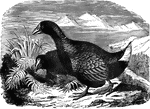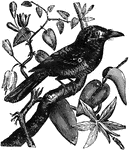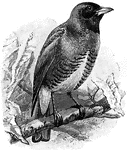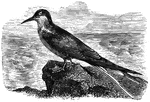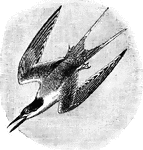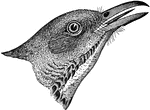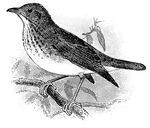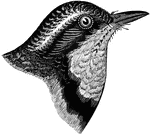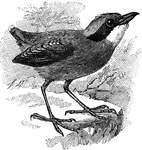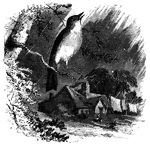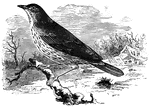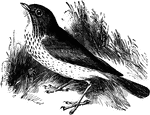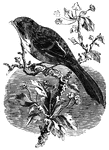152 illustrations of birds including: tailor bird, tamatia, tanager, teal, tern, thasher, thrush, titmouse, tock, tody, toucan, touraco, trogon, turkey, turnstone, umbrella bird, versicolor, vireo, and vulture

Tropic Bird Sitting on a Ledge
The Tropic Bird " are chiefly found in the tropical regions of the south; ... this species breeds as…
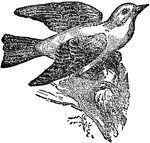
Tanager
A genus of birds belonging to the finch family. They are native to the warmer regions of America.
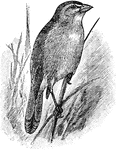
Tanager
The Texas Sparrow or Green Finch (Embernagra rufovirgata) is a finch-like tanager of the Embernagra…
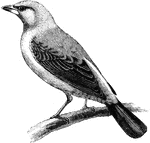
Brazilian Tanager
"Rhamphocoelus brasilius, the Brazilian Tanager, ...are chiefly small in size; the sexes are commonly…
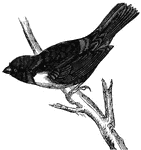
Scarlet Tanager
The scarlet tanager (also known as the black-winged summer redbird, or fire bird) feeds on insects,…
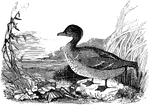
American Green-winged Teal
"Querquedula (N.) carolinensis. American Green-winged Teal. Bill black; feet bluish-gray: iris brown.…

English Teal
Common throughout Europe, the English teal is accidental to the East coast of the United States.

Green-Winged Teal
This duck is beautifully colored and resembles a mallard. Its wings have an emerald green patch upon…
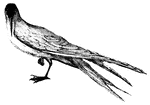
Tern
These birds are remarkable for their buoyant, graceful, easy flight, and the soft loose texture of their…

Aleutian Tern
"Sterna aleutica. Aleutian Tern. Bill of ordinary shape, as in hirundo, macrura, etc., entirely black.…
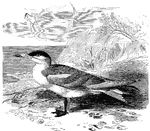
Caspian Tern
"Sterna (T.) caspia. Caspian Tern. Imperial Tern. Bill dark vermilion red, growing and somewhat "diaphanous"…

Common Tern
Sterna fluviatilis, the Common Tern, occupying the coasts and inland waters of Europe, temperate Asia,…
Elegant Tern
"Sterna (T.) elegans. Elegant Tern. Princely Tern. Bill bright red, salmon-colored toward tip. Feet…
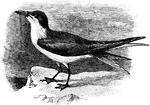
Gull-Billed Tern
The Gull-Billed Tern (Gelochelidon nilotica) is a bird in the Sternidae family of seabirds. It was formerly…
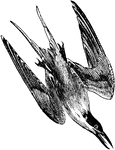
Roseate Tern
"Sterna dougalli. Roseate Tern. Paradise Tern. Bill about as long as head or foot, straight, slender,…

Royal Tern
"Sterna (T.) maxima. Cayenne Tern. Royal Tern. Adult in summer: Pileum glossy greenish-black, not extending…

Sandwich Tern
"Sterna (T.) cantiaca. Sandwich Tern. Ducal Tern. Bill black, the tip 1/2 to 3/4 an inch bright yellow,…
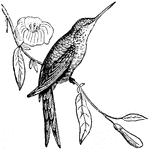
Columbian Thornbill
"They feed on honey extracted from flowers and the sap from the sugar-cane, the juice of which they…

Arizona Thrasher
"Bill shorter than head, comparatively stout at base, very acute at tip, the culmen quite convex, the…

Bow-Billed Thrasher
"Above, grayish-brown, nearly uniform; wing- coverts and quills with slight whitish edging, the edge…

Brown Thrasher
The Brown Thrasher (Toxostoma rufum) is a species of thrasher, part of a family of New World birds (Mimidae)…
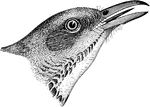
Brown Thrasher
"Upper parts uniform rust-red, with a bronzy lustre. Concealed portions of quills fuscous. Greater the…

California Thrasher
"No spots anywhere; wings and tail without decided barring or tipping. Bill as long as the head or longer,…

Crissal Thrasher
"Brownish-ash, with a faith olive shade, the wings and tail purer and darker fuscous, without white…
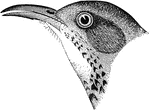
St. Lucas Thrasher
"Upper parts uniform ashy-brown; wings and tail similar, but rather purer and darker brown, the former…
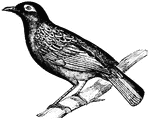
Thrush
The thrush flies indifferently, but in running and hopping they are very nimble.(Figuier, 1869).
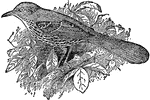
Thrush
A genus of birds common to all the continents and most of the islands. They embrace a great variety…
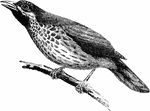
Babbling Thrush
"Timelia maculata, the Babbling Thrush, sexes are commonly alike, the plain rufous coloration being…
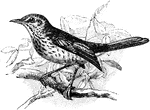
Fieldfare Perched on Branch
The fieldfare (Turdus pilaris) is a bird in the Turdidae family of thrushes.
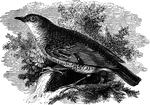
Golden Thrush
Also known as White's thrush, the golden thrush is native to Japan and Savabut migrates to Southern…
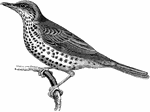
Mistletoe Thrush
"Turdus viscivorus, Mistletoe Thrush, the coloration is ordinarily plain black or brown, more or less…

Red-Wing Thrush
The red-wing thrush migrates from the north to the south of Europe in the winter, feeding on worms and…
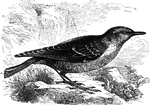
Rock Thrush
Inhabiting the higher reaches of Southern Europe, the rock thrush descends to lower altitudes during…
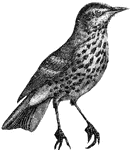
Song Thrush
The song thrush has enjoyed great reputation, not for its vocal powers, but for the deliacy of its flesh...…
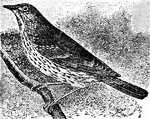
Song Thrush
"Thrush, in ornithology, is the name for any of the Turdidæ. They are universally distributed,…
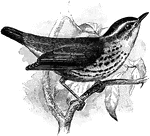
New York Waterthrush
The New York Waterthrush (Seiurus naevius) is a passerine bird of the New World warblers.
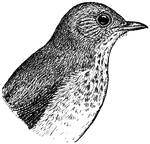
Wilson's Thrush
The Veery, Catharus fuscescens, is a small thrush species. It is occasionally called Willow Thrush or…
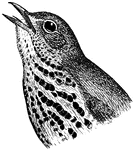
Wood Thrush
The Wood Thrush, Hylocichla mustelina, is a North American passerine bird. It is closely related to…

Wood Thrush
"Wood Thrush. Upper parts, including the surface of the closed wings, tawny-brown, purest and deepest…

Tinamou
"Tinamou is the name given to a genus and family of birds occurring in South America, and allied in…
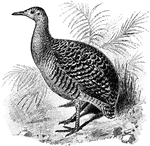
Tinamou
A large bird with varigated plumage, short soft tail feathers, well developed hind toe and long bill.
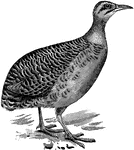
Red-winged Tinamou
"Rhynchotus rufescens,... is grey-brown, with blacker crown, rufous cheeks, neck, and breast, and chestnut…

Tit Bird
The tits, chickadees, and titmice comprise Paridae, a large family of small passerine birds which occur…
